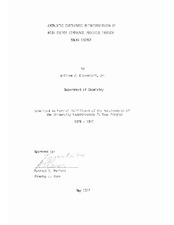| dc.description.abstract | Two systems were evaluated for their potential use in a novel photochemical solar energy storage method dubbed HELEOS (Hydrocarbon Entrapment of Light Energy of the Sun). This method consists of storing solar energy through photochemical production of high energy synthetic fuels and releasing the energy by catalytic conversion of the fuels back to the starting material.
The first system investigated was the model system consisting of the starting material norbornadiene (I), the fuel quadricyclene (II), and Wilkinson's catalyst both in polymer-bound (V) and unbound (IV) forms. This system was found to be ideally-suited for application in HELEOS, based on several criteria. First, the photoreaction of norbornadiene was found to have (i) broad band absorption in the UV-visible portion of the solar spectrum when used in conjunction with a photosensitizer known as Michler's ketone (III), and (ii) a high yield and specificity for production of quadricyclene , which was found to be optimized by reaction of norbornadtene in high concentration using benzene as the 501 vent. Second, quadricyclene was found to be thermally stable at ambient temperatures and quite reactive to catalytic conversion to norbornadiene; the second order rate constant for catalytic conversion was found to be 7.0 x 10⁻¹ M⁻¹ S⁻¹ for the unbound catalyst (IV), and 8.0 x 10⁻² M⁻¹ s⁻¹ for the polymer bound catalyst V (at 36°C). Finally, the conversion of quadricyclene to norbornadiene was found to be highly exothermic, releasing 24 kcal/mol at 25 C.
The second system studied consisted of the starting material N-methyl- 2-pyridone (VI, R = CH₃). and the fuels Dewar pyridone (VII, R = CH₃) and 4 + 4 dimer (VIII, R = CH₃). Conditions were found which optimized the production of each fuel from the starting compound VI, and both photoreactions were found to display both a high specificity for production of each respective fuel and broad band absorption in the UV-vis region of the solar spectrum. However, the fuels resisted catalytic conversion to the starting compound VI using a variety of catalysts at both ambient and elevated temperatures. For this reason, it has been decided that this system is unsuitable for use in a HELEOS - type application without some structural modifications of the fuels allowing facile catalyzed retroconversions to the starting compound VI. | en |


